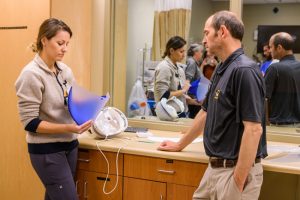July 29, 2020

An MU Health Care worker inspects a face shield produced by Mizzou Engineering staff.
In April, a volunteer group led by University of Missouri College of Engineering professor Kevin Gillis, DSc, met with MU Health Care leaders. The goal was to figure out the best ways to harness the talent of a cross-campus team of problem-solvers to make medical equipment to deal with the COVID-19 pandemic.
They decided the top priority was to stock an emergency supply of shields for controlled air-purifying respirator (CAPR) masks. CAPR masks are worn by doctors, nurses and respiratory therapists to guard against infection from airborne viruses such as COVID-19. Within two weeks, Gillis’ team designed, tested and produced 1,000 of the shields.
Stephen Barnes, MD, the leader of MU Health Care’s COVID-19 Incident Command, doesn’t want to imagine what would have happened without that emergency supply. An order of thousands of CAPR shields from the manufacturer did not arrive on the promised date of June 30 and, as of July 22, still hadn’t arrived. Since the beginning of July, MU Health Care workers have used the locally made shields.
“The No. 1 goal is to keep our people and our patients safe,” Barnes said. “We have to get creative when supply is unable to keep up with demand. Having an extremely talented and gracious campus makes that possible.”
Gillis, whose volunteer group’s name is the Hacking COVID-19 Task Force, gave the credit to the people working on the CAPR project. The CAPR team includes College of Engineering director of facilities Ron Monson; engineering technicians Ghassan Al Bahhash and Mike Harlow; and Damon Coyle from the MU School of Medicine’s Shelden Clinical Simulation Center.
A CAPR unit includes a helmet with an attaching shield-and-cuff combination that forms a seal covering the whole face. There is a fan in the helmet that filters air and pushes it down the wearer’s face, creating a positive-pressure environment inside the mask that keeps viruses out. It is worn when there could be a mist of infected fluid in the air. The helmets are permanent, and the shields can be worn a handful of times — with disinfection between usages — until the cuff stretches out too much to provide a tight seal along the jaw line.
Barnes has given up on ever receiving the ordered shield shipment from the manufacturer and said there aren’t any other shields available on the market. So in mid-July, he contacted Gillis and asked if the CAPR team could spring back into action and produce 2,000 more shields.
“With one-week notice, Kevin and the shop group are bringing the production back on line, this time in true manufacturing form with die-stamped cutting as opposed to manual cutting, which will increase production from 40 to approximately 100 per day,” Barnes said.
The group’s efforts will ensure that MU Health Care’s frontline workers can continue to serve mid-Missouri patients safely.